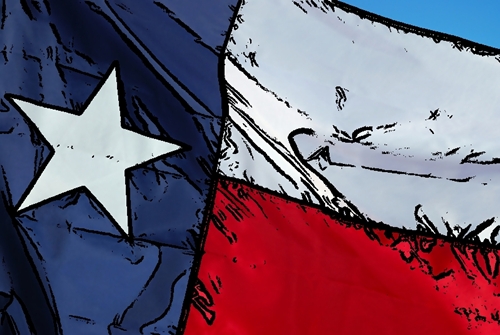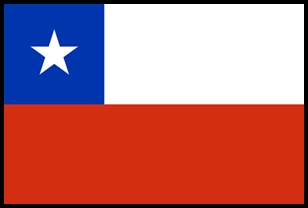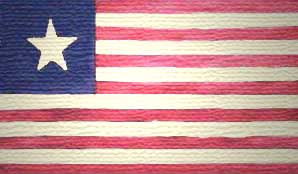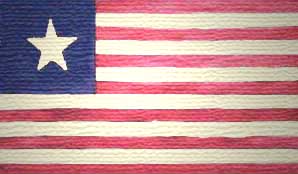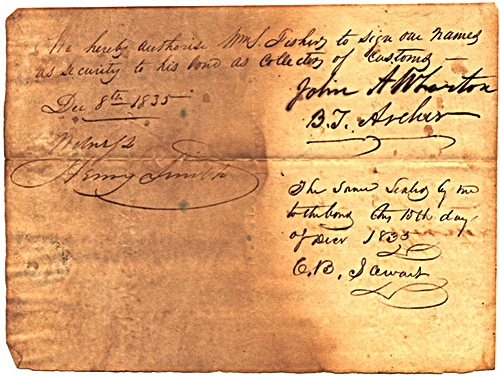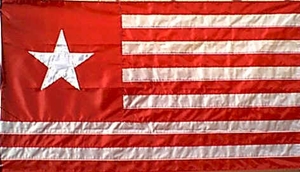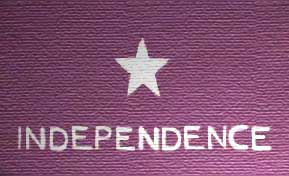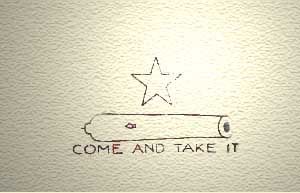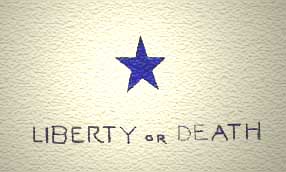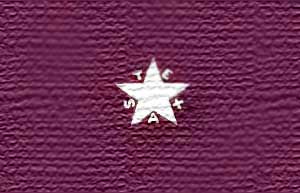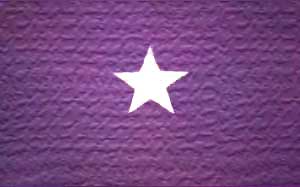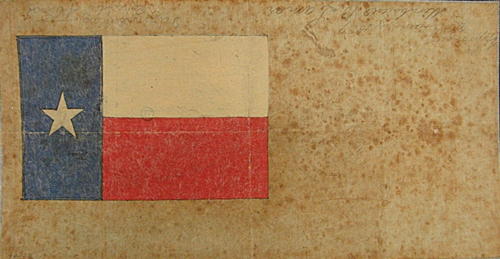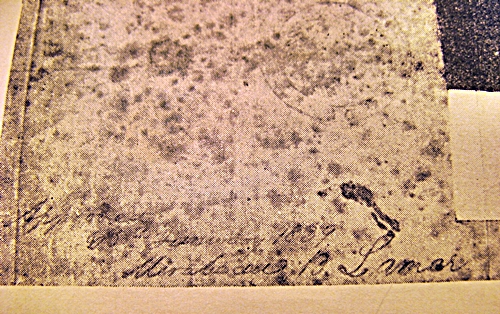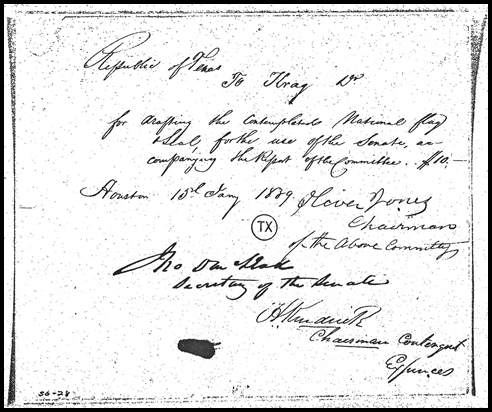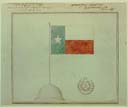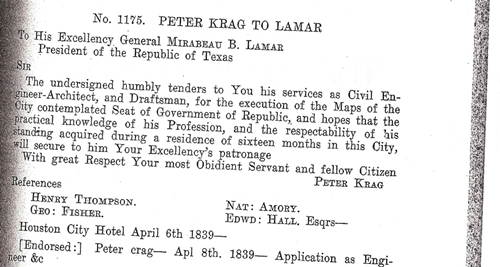
Origin of the Lone Star Flag
By David L. Martin
The design of any national flag is created from the passions and the needs of people that must “show their colors”. The origin of the Texas “Lone Star Flag” started long before the Texas revolution, a revolt that was due to Santa Anna´s abrogation of the special rights given to the “Estado de Tejas” under the Mexican constitution of 1824. The Lone Star Flag was created from concepts of human rights that blossomed from the “age of enlightenment” that in turn brought about the American and French revolutions that used combinations of the colors red, white and blue in their flags and in the case of the Americans, the addition of stars in a blue field. Men who were products of this era, such as, Sebastián Francisco de Miranda (Caracas, March 28, 1750 ….July 14, 1816), Joel Roberts Poinsett (March 2, 1779 – Charleston, South Carolina, December 12, 1851), David Gouverneur Burnet, (April 14, 1788 -New Jersey, Dec. 5, 1870 – Texas) brought the ideas of personal rights and revolution to South America and Texas. Sebastián Francisco de Miranda After a military and political career in Europe, Francisco Miranda returned to the western hemisphere to free his native land (South America) from French/Spanish rule. His vision was to establish an independent country that would encompass all the territory from the eastern border of the Spanish estado de Tejas to Patagonia (Argentina and Chile). On a trip to New York he conferred with American revolutionary leaders and recruited David G. Burnet, among others, to join him. After initial success with Miranda in Venezuela, David G. Burnet returned to the United States and studied law. David Gouverneur Burnet In 1817 Burnet entered the Spanish “estado de Tejas” and lived with the Comanche Indians for two years where he met Ben Milam. Burnet was elected the first President of the Republic of Texas (interim) and was instrumental in the adoption of at least three Republic of Texas flags. Joel Roberts Poinsett Joel Roberts Poinsett (March 2, 1779 – Charleston, South Carolina, Dec. 12, 1851) was also a product of the European “enlightenment” thinking and European military training. He was sent to South America by U.S. President James Madison to serve as an agent for the United States. He greatly influenced the revolutionaries in Chile with his nationalist governmental ideals and helped them write the first Chilean Constitution. While he was there, the U.S. warship Essex visited Valparaiso to show the “colors” as a warning to anyone who would interdict U. S. merchant ships. It is reported by Chilean history scholars that a U.S. citizen fighting with Chilean patriotic forces designed the first Chilean flag of the “Patria Vieja”. Whether it was Poinsett’s influence or other U.S. influence, the Chilean national flag and maritime flag first flown in 1817 that is called “la bandera Estrella Solitaria” is very closely tied to the United States.
La Bandera Estrella Solitaria - Chile 1817 This flag conceived by Jose Ignacio (Chilean Minister of War and Navy 1817-1822) and designed by Antonio Arcos use the “red, white and blue” with a star in the field of blue. It was very practical for the Chilean warships and merchant ships. When viewed from a distance, it was easily mistaken for a U.S. flag. Even the hesitation of several minutes by a hostile ship could give the Chileans an advantage. Some seventeen years later this same flag design was used in the Gulf of Mexico for the same reason. After Robert Poinsett left Chile and returned to the United States, he was appointed the first U.S. ambassador to Mexico and while there he made an abortive, ill timed attempt to buy Texas. Samuel May Williams Samuel May Williams (1795 – Providence, Rhode Island, 1858 – Texas) was another adventurer of the same era with more mercantile motives. His father was a sea captain and Samuel apprenticed in Baltimore with his uncle, Nathaniel F. Williams, a commission merchant who incidentally sold sails to Jean Lafitte and his brother for a privateering expedition sponsored by the rebel Argentinian government (Henson, 1976). In 1814 Samuel traveled to Buenos Aires on business and stayed there until late 1818. While there, he mastered the Spanish language and Latin American business practices and was exposed to such events as transfer of ownership of U. S. flagged frigates, outfitted for war, to the Chilean government in Buenos Aires harbor. On his return to the U.S., he stayed in New Orleans for a time in the same Hotel as Jean Lafitte. While there, due to an undisclosed problem, he found it to his advantage to reside under a different name. In 1822 Samuel left New Orleans and the United States under his assumed name to start a new life and career in Mexico, as did a lot of other “Americans” (U.S. citizens). In Tejas he worked for Stephen F. Austin and resumed his real identity and later entered into a partnership with Thomas F. McKinney doing business as McKinney and Williams Trading Company headquartered in Quintana, estado de Coahuila y Tejas. They had ships that carried their cargo along the coast of the Gulf of Mexico and in order to give their captain an advantage when encountering pirates or other hostile vessels, they used a maritime flag similar to what Samuel had seen the Chilean Navy use in South America.
As evidenced by pictures on some of their shipping invoices from 1834, they used a flag designed with the “red, white and blue” using a star in the blue field. They used a design that was even closer to the U.S. flag than the Chilean “Estrella Solitaria” because they used thirteen red and white stripes, rather than two. This flag might have been used on the steamship “Yellowstone” that was leased by McKinney and Williams to pickup cotton at Jared Groce´s landing on the Brazos River. On March 31, 1836 while at Groce´s, the Yellowstone ferried the whole Texian Army under the command of General Sam Houston to safety on the east bank of the rain swollen Brazos River and out of harm’s way of the advancing armies of General Antonio Lopez de Santa Anna. McKinney and Williams also gave the new Republic $100,000.00 to buy ships and outfit them for the First Navy of the Republic of Texas. The Texas (Mexican breakaway State) Naval flag (Mexican tricolor with 1824 in the white field) approved by the Consultation for “Marque and Reprisal" was being confused with the Mexican National tricolor on the high seas.
Because of this, on April 9, 1836 President David G. Burnet authorized the McKinney and Williams maritime flag (sometimes later called the Hawkins flag) as the first Republic of Texas Navy Flag. Charles Bellinger Stewart Charles Bellinger Stewart (1806- Charleston, South Carolina 1885 – Montgomery, Texas) was another adventurer/entrepreneur that was involved in Latin-American maritime trade. He was also involved with the revolutionary passions of the region and the last Republic of Texas Flag. He studied medicine in South Carolina and later received a license in pharmacy there while working for Phelps and Bonner, Druggists. In 1828 while on a trip to Cuba, he formed a trading partnership with Laurenz Sanchez, a Spaniard. They bought a small vessel for trade between the United States and Cuba at which time Stewart would have been well aware of the advantage of using a flag similar to the U. S. flag on the open sea. In 1829 and 1830, Mr. Stewart was in New Orleans handling the U. S. side of the partnership importing among other things, coffee. While in New Orleans Mr. Stewart met Stephen F. Austin and as a result in 1830 he moved his business to Brazoria, Coahuila Y Tejas, Mexico. When Antonio Lopez de Santa Anna took over the government of Mexico and abrogated the special rights of the settlers in Tejas, Mr. Stewart and others actively protested these changes. One of the changes was the imposition of import duties. When William Barrett Travis and Patrick Jack were arrested by the Mexican military commander, John Davis Bradburn, Charles Stewart was among colonists that obtained their release. According to the family, Travis and Dr. Stewart were friends and when Travis departed for Bejar to fortify the Alamo, he stopped at Stewart’s store in San Felipe de Austin for a cart load of supplies including medical supplies. In 1832 when Domingo de Ugartechea and his soldiers tried to stop the Texians and their cannon from going down the Brazos River, Charles Stewart was with John Austin, Henry Smith and the colonists. During the battle that ensued, Mr. Stewart was “detailed to make a reconnaissance, and to get a good view of the surrounding country, he climbed a large oak. Very soon he was discovered by a Mexican sharpshooter whose marksmanship proved bad, as one of the balls fired by the Mexican struck the trunk of the oak near the head of Dr. Stewart.” Mr. Stewart went on to become a licensed physician by the Mexican government on May 4, 1835.
He was appointed as executive secretary of the consultation under Branch T. Archer and then after November 1835, under Governor Henry Smith for the State of Texas of Mexico (separated from the estado de Coahuila y Tejas). Dr. Stewart was the first delegate to sign the Declaration of Independence of The Republic of Texas (after the president of the convention, Richard Ellis) and he went on to hold many public offices of The Republic and well as the State of Texas of the United States. There were many flags of the Texas revolution other than the McKinney and Williams that expressed the local inhabitant’s sentiments and passions. A good many of them did not encompass the lone star theme, however at least nine did champion the single or lone star such as:
The James Long, Filibuster Flag of 1818 The first Lone Star Flag of Tejas. Col. James Long was a U. S. Army surgeon who organized an expedition into the Spanish estado de Tejas with the intent of establishing a new republic there. He was married to Jane Wilkerson Long whose determined character and wise counsel earned her the title of “mother of Texas”. Mrs. Long’s uncle, Gen. James Wilkerson supported Dr. Long’s expedition with encouragement from Andrew Jackson. After the expedition failed and Dr. Long died as a result of an intrigue in Mexico City, Jane Long stayed on and lived the rest of her life in Texas. The Coahuila y Tejas Flag about 1824 This flag came about sometime after combining los estados de Coahuila y Tejas as a result of the Mexican constitution of 1824. There are several reports that this flag was flying over the Alamo when Santa Anna’s army overran it.
The Dodson Flag - September 19, 1835 The Harrisburg committee of vigilance and safety upon hearing Gen. Martin Perfecto de Cos (el cuñado de Antonio Lopez de Santa Anna) planned an invasion of Texas, formed a company of volunteers which included Archelaus Bynum Dodson. Archelaus’ young wife Sarah Bradley Dodson designed and with help of other Harrisburg women, made the first tricolor Lone Star flag of Texas. When the company of Andrew Robinson, Jr., was mustered into the revolutionary army in 1835 she presented it to the members. The Robinson company participated in the siege of Bexar and the capture of the Alamo.
The Scott Flag 1835 Late 1835, Capt. William Scott, one of Stephen F. Austin's original "Old 300" colonists, wanted a flag for his Militia Company of 32 Lynchburg, Texas men that showed a desire for independence, so he gave about 4 yards of blue silk to his Second Lieutenant, James L. McGahey to make a flag. Lt. McGahey took the silk to Mrs. Joseph Lynch to sew the flag. He then asked Charles Zanco, a local painter originally from Denmark fo paint a large 5 pointed white star in the middle of the blue silk. Zanco said the flag looked rather plain, so McGahey told him to paint the word INDEPENDENCE under the star, and the Scott Flag was born. The Scott Flag may have been destroyed in the fall of the Alamo where Charles Zanco died on March 6, 1836.
The Come and Take It Flag - October 2, 1835 A large group of Texans under Colonel John H. Moore gathered in Gonzales and waited for the Mexican Army to come to attempt to take their cannon back on the western side of the Guadalupe River. While waiting for the Mexican Army to arrive, Cynthia Burns and Evaline “Sarah” Sealy, the wife of Green DeWitt, made a flag from the white silk wedding gown of her daughter Naomi DeWitt, who married William A. Matthews. They painted a cannon on the flag under a Lone Star, and the words, “Come-and-Take-It” were written below the cannon, and some historians say also above the cannon.
Joanna Troutman Flag - November 1835 When Texans sent out an appeal for help against the Mexican army in November 1835, the Georgia Battalion was organized in that state, drawing men from small towns and large. Joanna Troutman's brothers and cousins were involved, and she sewed a silk banner to be flown as the battalion's battle flag. She sewed a five-pointed blue star on both sides of the banner, with "Liberty or Death" on one side and "Ubi libertas habitat. Ubi nostra patria est" ("Where liberty dwells, there is our country") on the other. Joanna's flag was accepted and accompanied the Georgia Battalion to Texas, where it was first unfurled Jan. 8, 1836, over the Americana Hotel in Velasco. That night, as it was being lowered, the silken banner was ripped into pieces but the tattered remnants were hoisted aloft as the battalion flag. From Velasco, the Georgia Battalion marched to Goliad, where it joined the Texas troops under Col. James Fannin. Texas was declared free from Mexico at Washington-on-the-Brazos on March 2, 1836, and Joanna's Lone Star banner was flown at Goliad on March 8. After the Goliad massacre of March 27, no part of the tattered banner was saved. Selecting a flag for the new republic had been on the minds of the delegates and the people of Texas for some time. In February 1836, before his capture and execution by the Mexicans after the battle of Coleto Creek, Colonel Fannin had written: "Give us a flag to fight under, as unlike theirs as possible. We need one and have nothing [here] to make it of, and hope the Convention will furnish one in time to hoist it in defiance of Santa Anna." Col. Fannin (Mamie Wynne Cox 1936) As the convention records of March 12, 1836 reflect, the citizenry of the Republic was unified not only for their rights, but their vision of Texas as a star strong enough to prevail on its own. As early as March12, 1836 the “star” was adopted as the symbol of “the republic” by the “convention”.
Zavala Flag - First Flag of the Republic - May 11, 1836 The first Constitutional Convention had begun its work by declaring Texas' independence from Mexico, writing a new constitution and electing the first leaders. A committee of five delegates, Lorenzo de Zavala, William B. Scates, Thomas Barnett, Sterling C. Robertson, Thomas J. Gazley and by invitation of the committee, Richard Ellis, all signers of the Texas Declaration of Independence, was selected and their choice for a design for a new flag was approved by the entire convention on May 11th, 1836. The design was a blue field with a white star of five points central, with the letters T E X A S between the star points. Interestingly, Zavala, a native of Spain, had served as Mexico's Secretary of the Treasury, Minister to Paris and as President of the Mexican Constitutional Congress in 1824 before siding with the Texians. This is probably the most romantic and mystical flags of the Republic Flags. Did it ever exist? Was it this design? There are reports that it did. Maybe this design was too popular not to have existed. A facsimile of this flag was on the back of all the “red back” Republic of Texas currency from 1837 until 1839.
Burnet Flag - December 10, 1836 The “Burnet Flag” was named for the first provisional President of the Republic of Texas, David Gouverneur Burnet who was elected by the delegates at the March 1836 Convention at Washington-on-the-Brazos. After the victory at San Jacinto, President David G. Burnet suggested the design for this flag in a November 11, 1836 letter to the first Republic of Texas Congress. The first Congress of the Republic of Texas met in Columbia, Texas beginning on October 3, 1836 at a small modest house. At this first Republic of Texas Congress a bill was sponsored to adopt a “National Standard” consisting of an azure blue flag with a single gold star in its center. On December 10, 1836 the resolution was signed by Speaker of the House, Ira Ingram and the President Pro Tem of the Senate, Richard Ellis, who had served as President of the March 1836 convention at Washington-on-the-Brazos. The bill was signed by the newly elected President of the Republic of Texas, Sam Houston. This was the official flag of the Republic of Texas from December 10, 1836 until January 25, 1839 when our current State of Texas flag was adopted as the Republic of Texas flag. When Dr. Charles Stewart and the other delegates to the constitutional convention at Washington on the Brazos signed the Texas Declaration of Independence, they were signing their death warrant if captured by Santa Anna. As soon as they completed the Texas Constitution, they had to join the “runaway scrape” and keep moving the new government out of harm’s way. They were still doing the new Republic’s business as they fled. One of the committees that was in place during that time was the Zavala flag committee. In 1836 while C. B. Stewart was serving as a delegate to the Republic of Texas Constitutional Convention at Washington on the Brazos, he left the proceedings with Judge James Hall’s authorization for W. W. Shepperd to officiate over the marriage of Julia Shepperd and Stewart. W. W. Shepperd performed the marriage between his daughter Julia Shepperd and Dr. Stewart at Lake Creek Settlement on March 11, 1836. Stewart returned to the Convention to complete his duties concerning the Declaration of Independence and writing of Constitution of the Republic of Texas. Authoritative sources quote a letter written by Sam Houston that states that Charles Stewart was at the San Jacinto battle and assisted as a translator after the battle. When Dr. Stewart returned to San Felipe de Austin in 1836, he found his business had been burned and all his merchandise in ashes. In late 1837/early 1838 Dr. Stewart started working with his father-in-law to develop the town of Montgomery and subsequently re-established his apothecary along with his medical practice. In 1838 W. W. Shepperd and Dr. Stewart donated land and buildings to help establish the county of Montgomery, Texas. The Lone Star Flag of Texas - Charles B. Stewart - 1839 In late 1838 Dr. Stewart with some old acquaintances and political allies from as far back as the disturbances at Anahuac (Oliver Jones, Richard Ellis, Thomas Barnett and Charles Stewart..see index) were members of a committee sponsored by William H. Wharton to create a new national flag. Dr. Stewart frequented Houston as part of his normal business activities and his involvement with the committee included making the first freehand drawing of the flag conceived by the committee. The Charles Stewart flag, the original drawing of the third flag of the Republic of Texas, is a “free hand” drawing of the concept of the flag committee of 1838 - 1839. The original is in the Sam Houston Library and Research branch of the Texas State Archives. It was described as on linen in 1936 by Mamie Wynne Cox, DRT (reporter and author) and the seal is on one side and flag on the other. It was not originally colored, having the letters of the colors written into their appropriate spaces (as you can plainly see even today). Early family records state that some of the Stewart children colored the spaces of the flag and Mr. Stewart was upset about it. The Stewart seal and flag are irregular and the star is not concentric which is consistent with a “freehand drawing.”
The Lamar signature on the Stewart flag when photographed in 1936 by Mamie Wynne Cox was more natural and flowing than it is now (after preservation). Peter Krag's Draft of Charles Bellinger Stewart's Design of the Lone Star Flag A copy of the original flag was needed, as was customary for all documents at that time, and Peter Krag was contracted : "for drafting the contemplated National flag & seal for the use of the Senate, as accompanying the Report of the Committee. $10.~~ Houston 15th Janry 1839. Oliver Jones Chairman of the above Committy " Webster’s definition of drafting is copying or recreating.
Courtesy of Texas Sate Library and Archives Krag's draft was on paper, so it was apparently intended to accompany the flag legislation and was kept with the congressional records through the years. There has always been a slight mystery, because both flags were signed upside down, as if they had been pushed across the table. In any case, that seems to prove they were signed a the same time. Peter Krag had been in Houston for about a year prior to being hired to do the draft (copy) of the Stewart flag. He did a very good job. The pride in his craftsmanship shows in his work and in his job application to President Lamar a couple of months later (see below).
In 1997 the Texas legislature confirmed that Montgomery County is the home of the Texas Lone Star Flag by reading House Resolution 1123 into the legislative record. In Conclusion: This subject was researched thoroughly to bring to light all possible documentation available at this time concerning the origin of the Texas Lone Star Flag. The research has shown that Wharton, Stewart, Williams, Ellis, Barton, Burnett, Jones, and others mentioned in the article moved in the same social and sometimes family circles from the early 1830's and on through to the confrontation at Anahuac, the Consultation days, the writing of the Constitution of the Republic of Texas and the first few years of the Republic of Texas. They were some of the major decision makers and most of them knew the value of the red, white and blue flag with a star. They all had roles in developing the Texas Lone Star Flag as a group and as individuals. William H. Wharton has been given credit by some for putting these colors together to create the Lone Star Flag. However, we have a record of the flag he proposed and it was much different than the Lone Star Flag. It was designed for political purposes and the record shows that it was possibly used once. Research shows that Peter Krag did not design the flag, either. He was an architectural draftsman new to Texas in 1839 and was paid $10 for a draft (copy) of the original freehand drawing of the Lone Star Flag. Documentation provided for this article and family history in the form of first-person verbal accounts by his son and daughter confirm that the original freehand drawing of the first Texas Lone Star Flag signed by President Mirabeau B. Lamar on a piece of linen was the work of Dr. Charles Bellinger Stewart. In 1997, the Texas Legislature confirmed that Montgomery County, Texas (where Charles Bellinger Stewart lived in 1839) was the home of the Texas Lone Star Flag by reading House Resolution 1123 into the legislative record. My thanks to the many friends and colleagues who provided valuable research, documentation and advise for this article.
BibliographyCombs, J. F. (n.d.). Son of Signer of Texas Independence Preserves Many Original Paper. Cox, M. W. (1936). The Romantic Flags of Texas. Banks Upshaw and Company, Dallas. Delaney, F. M. (1976). Signers of the Declaration of Independence of Texas. Dallas Morning News . Dixon, S. H. (n.d.). Men Who Made Texas Free. Drake, J. C. (2008). A Brief History of the Texas Navy Flag. The Texas Navy Association . First Signer of Texas Independence Charter Was Medical Pioneer. (March 3, 1940). The Houston Chronicle . Henson, M. S. (1976). Samuel May Williams: Early Texas Entrepreneur. Texas. Robertson, W. S. (1907). Francisco de Miranda and the Revolutionizing of Spanish America. Annual Report of the American Historical Association for 1907, pp. Volume 1, pages 189-540. SAMUEL MAY WILLIAMS, Texas Pioneer, Businessman and Freemason. Grand Lodge of texas. Texas, D. C. (1836). Journals of the Convention of the Free, Sovereign, and Independent People of Texas, in General Convention, Assembled H.P.H. Gamel, The Laws of Texas, 1822-1897, Volume 1. Journals of the Convention, page 890.
This page is still under construction. It will be complete in about a week. Please check back by. Thank you for your patience. 2/7/09
Copyright David L. Martin 2008 All Rights Reserved This article appears on the Texas History Page by permission of David L. Martin. |
